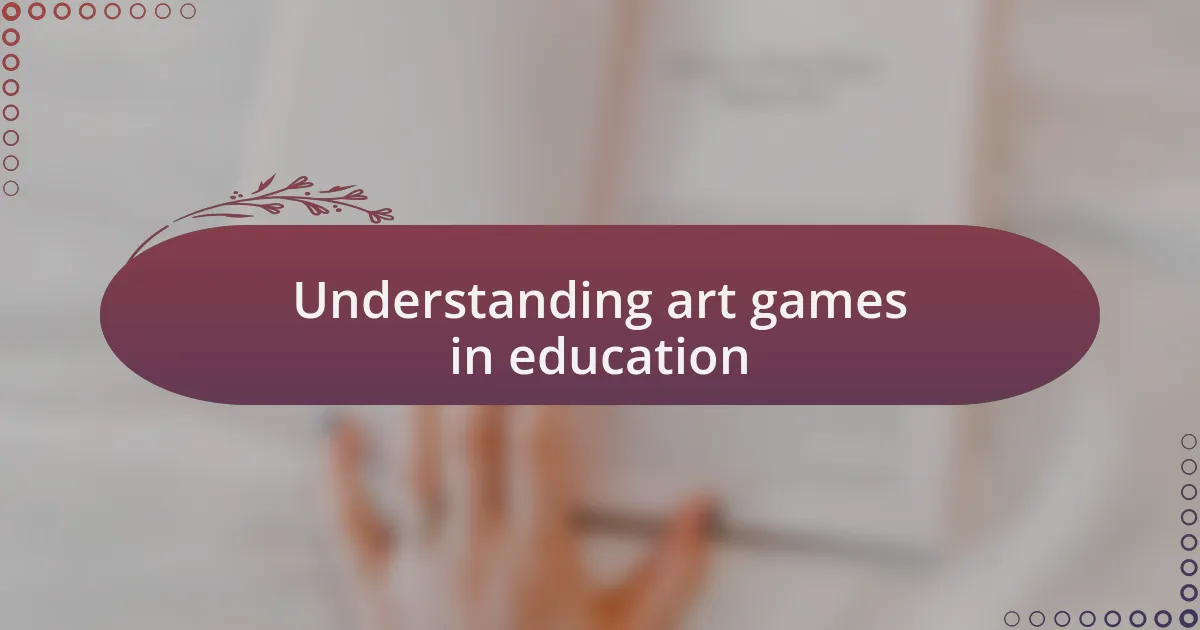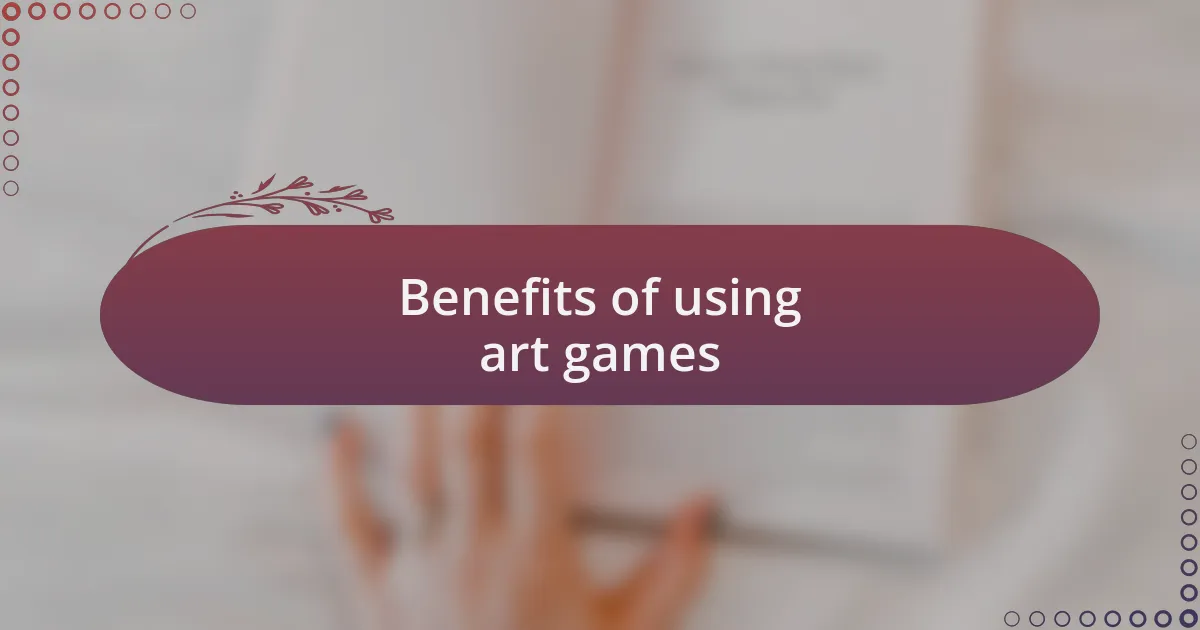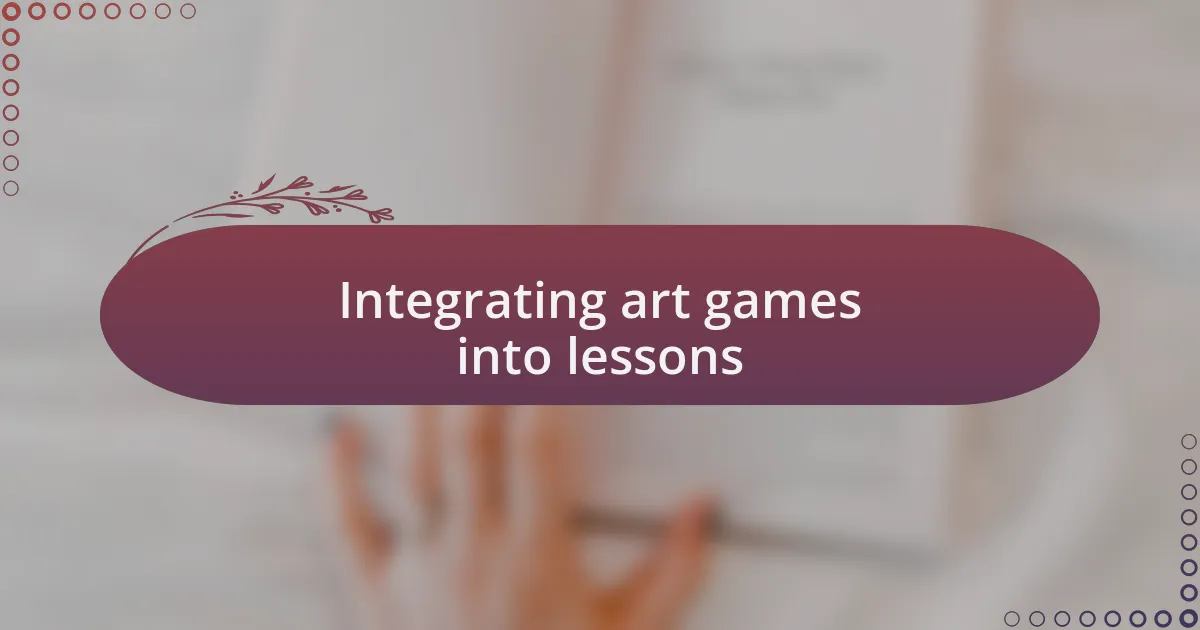Key takeaways:
- Art games enhance creativity, allowing students to express themselves and build confidence through self-directed projects.
- They foster collaboration and critical thinking, enabling students to solve problems and make informed decisions during gameplay.
- Art games support emotional engagement and resilience, providing a medium for authentic expression and encouraging a growth mindset when facing challenges.
- Integrating art games into lessons can deepen understanding of complex concepts while catering to diverse skill levels and interests among students.

Understanding art games in education
Art games, in my experience, are powerful tools that can bridge theoretical concepts with practical application in education. For instance, I once facilitated a class where students created their own video game levels, integrating art and storytelling. The excitement in the room was palpable, and I found that seeing their ideas come to life not only sparked their creativity but also bolstered their understanding of narrative structure.
Engaging with art games allows students to experiment without fear of judgment, fostering a safe space for self-expression. I recall one shy student who rarely participated; through an art game, she found her voice, illustrating game characters that reflected her own life experiences. Isn’t it fascinating how creative outlets can reveal hidden talents and build confidence?
Moreover, art games encourage collaboration and problem-solving. I’ve witnessed students brainstorming together, their discussions buzzing with energy as they tackle challenges within the gaming framework. Have you ever noticed how these interactions often lead to deeper friendships and a more cohesive learning environment? Simply put, art games enrich both individual and collective educational experiences in meaningful ways.

Benefits of using art games
Using art games fosters critical thinking skills, something I’ve seen firsthand when students have to devise strategies for their creations. I recall a project where a group needed to design a character that could navigate complex terrains. The conversations were electric—they were not just making choices; they were weighing pros and cons. Isn’t it intriguing how gaming can sharpen our decision-making process while being incredibly fun?
Another significant benefit is the emotional engagement that art games provide. When I introduced a game that allowed students to express their feelings through visual storytelling, I observed a remarkable transformation. One student created a narrative that addressed her anxiety, and it resonated with many others in the class. Don’t you think it’s powerful when art becomes a medium for authentic emotional expression?
Art games also build resilience. I remember a time when my students faced numerous setbacks while coding their game levels; frustration was in the air. However, by encouraging them to reframe their challenges as opportunities for improvement, I witnessed their determination strengthen. Have you experienced that satisfying moment when persistence pays off? It’s truly rewarding to see students rise to the occasion and develop a growth mindset in the process.

Types of art games available
When it comes to art games, there’s a diverse array available that caters to various interests and skills. For instance, some games focus on digital drawing or painting, allowing users to experiment with color and form in a virtual space. I remember the excitement in a workshop where students used a digital canvas, their creativity flowing as they combined traditional techniques with modern tools. Can you feel the thrill of creating something that exists solely in the digital realm?
Another fascinating type is storytelling games, which blend narrative and visual art. I once facilitated a session where students crafted comic strips based on prompts. The results were astounding! Not only did they enhance their artistic skills, but they also honed their ability to weave a compelling narrative. Have you ever considered how visual art can add depth to a story?
Finally, there are collaborative art games that encourage teamwork and interaction among participants. During one project, I organized a group mural where each student contributed to a larger piece. The energy was palpable as they communicated their ideas and negotiated design choices. Isn’t it incredible how art can foster collaboration and create a sense of community among creators?

Integrating art games into lessons
Integrating art games into lessons can transform a standard classroom into an interactive playground for creativity. I once introduced a drawing challenge where students had to create a character using a limited color palette from a digital art game. The anticipation in the room grew as they realized they had to think outside the box, sparking lively debates over color choices and design elements. Have you ever witnessed how a simple game can shift the classroom dynamic?
I’ve found that combining art games with lessons on historical or cultural themes can deepen students’ understanding. For instance, I had my class depict famous art movements through an online collaborative platform. Each student contributed their interpretation of styles like Cubism or Impressionism, and the variety was eye-opening. It’s amazing how engaging with art in a playful way allows students to internalize complex concepts.
Moreover, integrating these games can cater to varying skill levels and interests, ensuring all students feel included. I remember a hesitant student who rarely engaged in traditional art exercises; however, when we employed a digital storytelling game, they flourished, sharing their ideas with enthusiasm. This experience made me realize that art games can act as a bridge to unlock hidden talents and foster a love for creativity. Isn’t it fascinating how the right tool can make all the difference in a student’s artistic journey?